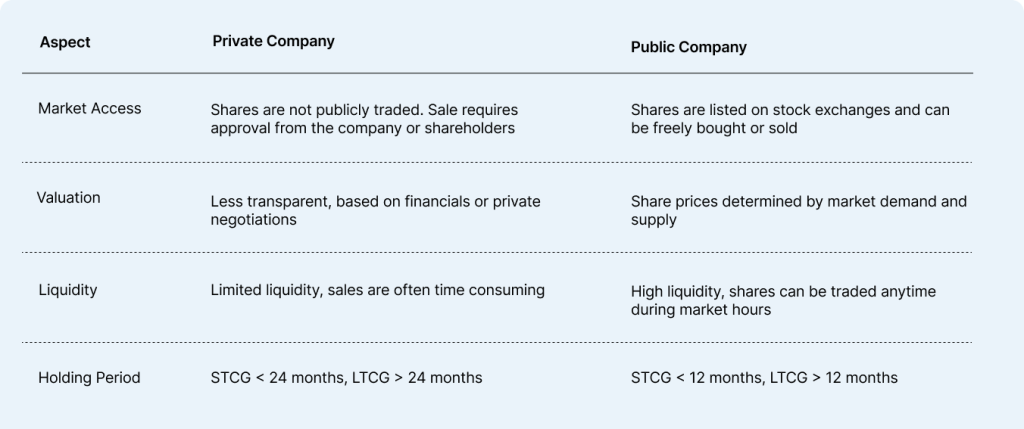Ever feel like there’s a mysterious hand taking a cut of your hard-earned money? That’s taxes for you. One minute you’re celebrating financial success, and the next, a significant portion is gone. When it comes to selling shares in private companies, the story is no different.
Let’s break down capital gains tax so you can manage your wealth better in this blog.
What is Capital Gain?
In our previous blog, we discussed perquisite tax, which hits first when you exercise your stock options . Capital gains tax on the other hand arise when you sell an asset — like shares, real estate, or other investments — and make a profit.
Think of it like your salary. Your Cost to Company (CTC) looks great on paper, but after deductions, your take-home salary is much less. Capital gains work the same way. The profit from selling an asset might seem like a windfall, but taxes ensure your real earnings are significantly lower.
It’s the battle of what is and what you get.
How Does Capital Gains Tax Work for Private Company Shares?
Let’s say you’re an employee who’s exercised your vested stock options. You now own 100 shares in your company, and the market value per share is ₹10,000. That means you’re holding ₹10,00,000 worth of shares. Whoa, that seems like a good deal, right? But lurking in the shadows is something ready to take a chunk of this wealth. That’s where taxes on capital gains come in, and suddenly, the wealth you thought you had isn’t as much as it first seemed.
Capital Gain Tax Treatment
- When you sell shares in a private company, the capital gain is calculated as — Number of shares being sold × (Sale price − FMV on date of exercise)
- The holding period of your shares affects how the gains are taxed.
- Short-Term Capital Gains (STCG) apply if the shares are held for less than 24 months.
- Long-Term Capital Gains (LTCG) apply if the shares are held for more than 24 months. LTCG is typically taxed at a lower rate than STCG.
- Non-residents must declare capital gains in Indian tax returns.
- Non-residents may benefit from lower tax rates or exemptions under India’s DTAA with their country of residence.
In the example above, the capital gains tax, assuming a sale price of ₹20,000 per share and employee salary of ₹15,00,000 will be calculated as follows:
1. Determine Gross Sale Proceeds:
Sale price per share = ₹20,000
Total shares sold = 100
=₹20,000 × 100
= ₹20,00,000
2. Calculate Capital Gains:
Purchase price per share = ₹10,000
Total purchase cost = ₹10,000 × 100
= ₹10,00,000
Capital Gains = Gross Sale Proceeds — Purchase Cost
= ₹20,00,000 — ₹10,00,000
3. Short-Term Capital Gains (STCG): Old Tax Regime:
Standard Deduction= ₹50,000
Total Income = Employee Salary + Capital Gain
=10,00,000+15,00,000
= ₹25,00,000
Total Taxable Income
= ₹25,00,000–₹50,000
= ₹24,50,000
Tax Rate on Taxable Income= 30%
Applicable Tax Bracket= ₹ 10,00,001 to ₹ 50,00,000
Tax Calculation = ₹1,12,500 + 30%* (₹24,50,000-₹10,00,000)
=₹5,47,500
Cess= ₹5,47,500*4%
= ₹21,900
Total Tax= ₹5,69,400
Short-Term Capital Gains (STCG): New Tax Regime:
Standard Deduction= ₹75,000
Total Taxable Income= ₹25,00,000–₹75,000
=24,25,000
Tax Rate on Taxable Income= 30%
Applicable Tax Bracket= ₹15,00,001- ₹50,00,000
Tax Calculation= ₹1,40,000 + 30%*(₹24,25,000- ₹15,00,000)
= 4,17,500
Cess= ₹4,17,500*4%
=₹16,700
Total Tax= ₹4,34,200
4. Long-Term Capital Gains (LTCG):
Flat tax rate = 12.5% on Taxable Sale Proceeds
Taxable Sale Proceeds= ₹20,00,000–₹10,00,000
= ₹10,00,000
Tax = 12.5% of ₹10,00,000
= ₹1,25,000
Cess=₹1,25,000*4%
= ₹5,000
Total Tax= ₹ 1,30,000
Difference in Sale of Shares between Private Company and Public Company
Stock Options Exercise Survey Results

From Exercise to Exit: Navigating Sale of Private Company Shares
1. Buyback by the Company
In a company buyback, the company purchases shares directly from employees, providing them with cash in exchange. This process is convenient as employees don’t need to wait for the company to go public to liquidate their shares.
2. Corporate Restructuring
In mergers or acquisitions, companies often offer liquidity to employees through share buybacks or accelerated vesting of stock options. Employees may exercise their vested options, after which the company buys back the shares. Some plans allow for accelerated vesting to fast-track the process and help employees capitalize on the transaction.
3. Sale to a Secondaries Fund
Since private company shares aren’t traded on public markets, employees can sell their shares to secondaries funds to access liquidity. These funds allow employees to sell shares acquired through exercised stock options, offering immediate cash. This approach provides flexibility, enabling employees to sell all or part of their shares based on financial needs.
Each of these options offers a pathway for employees to unlock the value of their private company shares, tailored to different scenarios and liquidity needs. In all cases, the holding period decides if the gain will be an STCG or LTCG.
Calculating capital gains tax can be a complex task, especially when using spreadsheets. You can try to ascertain your tax liability using the Capital Gains Tax Calculator in the spreadsheet, but the manual process can be time-consuming and tedious.
Luckily, there’s an easier way! Hissa simplifies the entire process. With Hissa’s intuitive dashboard, you can track your equity holdings in real time, calculate taxes, model different scenarios, and plan for your financial future — all without the hassle of spreadsheets.


